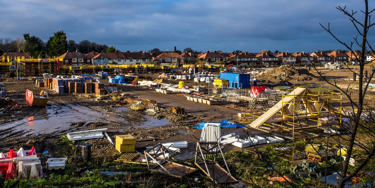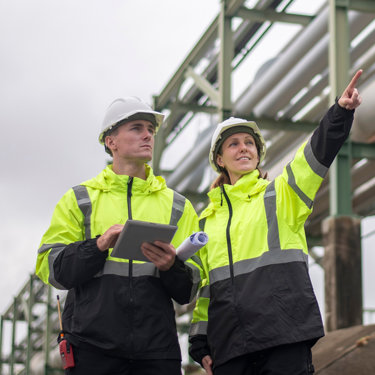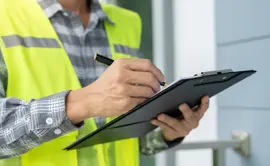Contaminated land: Economic implications and mitigation strategies
Published: 24 October 2024
How does contamination affect the value of land, property, and businesses? Let’s look at the uncertainties and potential costs that come with investigating and cleaning up sites affected by contaminated land.
It’s important for property owners, acquisition managers, real estate professionals and community stakeholders to get a handle on these issues – especially during transactions. When developing land, you’ll need to investigate upfront to figure out the likely costs and time involved. We have become a go-to partner for many big organisations because our experienced environmental consultants have tackled some of the UK’s most contaminated sites with cost-effective solutions.
What is land contamination?
Land contamination refers to the presence of hazardous substances or pollutants in soil, water or air which can have a detrimental impact on human health and the environment. The most common sources of contamination are from past and present industrial activities and waste disposal sites; basically, any use involving hazardous or toxic materials. Contaminants can include heavy metals, petroleum hydrocarbons, chlorinated solvents, PFAS, asbestos and ground gas, among many others.
As defined under Part 2A of the Environmental Protection Act 1990, a risk from land contamination can only be present when:
- There is a source of contamination present
- A pathway by which the contamination can migrate
- And the ultimate presence of a receptor (a ‘pollutant linkage’)
Depending on other factors, like how the site is going to be used and its current operations, if there’s a proven unacceptable risk from land contamination, this is likely to instigate the need for remediation. Even if you’re not legally required to do so, it may be in the best interests of those involved to undertake an appropriate assessment to understand the potential risks.

Understanding the economic implications of contaminated land
A significant reason why property or land values can be negatively impacted is the remediation costs involved in making the site suitable for use and meeting environmental standards. This should ensure all potential health risks and wider environmental impacts are taken care of.
In March 2015, the Homes and Communities Agency (now Homes England) issued guidance on dereliction, demolition and remediation costs. The report concluded that remediation for a low-potential and low-sensitivity site could cost in the region of £50,000–£250,000, and for a high-potential and high-sensitivity site, the costs were £335,000–£1,765,000. These costs are considered representative of the UK as a whole.
If environmental investigations show that remediation is needed, property and land values might drop substantially to account for these potential costs and regulatory input. Investors might also struggle to secure financing as lenders could see them as high-risk, especially since remediation costs can be tough to fully estimate.
Overall, whether it’s residential, commercial or industrial real estate, land contamination can seriously impact land and property values. If a site needs remediation, the costs will likely fall on the current landowner or polluter, but tenants might also be partially or fully responsible, leading to unexpected legal fees and business disruption as the issue is addressed.
Not only can land value drop, but there might also be usage restrictions.
- The land (or part of it) may not be useable while the remediation works are being completed
- Because of the high clean-up costs, the land might only be deemed suitable for industrial use, not something like residential use, which, due to the higher sensitivities involved, would be more expensive to clean up.
In an era of social media and fast communication, reputational issues should also be a major consideration. Any negative buzz about land contamination could add extra financial pressure on a business.
The importance of environmental due diligence
Before you buy or lease land, it’s important to understand any environmental liabilities and potential costs. If an investor doesn’t think about these economic factors beforehand, they might find it hard to sell the property later. As a leaseholder, you could also end up responsible for cleaning up historic contamination that wasn’t caused by your operations.
During the due diligence process, other parties may be able to help with understanding future contamination liabilities. For example, legal agreements can outline who’s responsible for what, so it’s a good idea to liaise with the buyer’s solicitor. There may also be insurance options to cover environmental liabilities. While it’s important to consult with solicitors and insurance brokers, everyone involved needs to understand the extent of the land contamination.
Contaminated land and the costs involved can be subjective. As a seller, having expert support is key to maximising your asset’s value and minimising future liabilities.

Uncertainties and cost variations
So, what can introduce uncertainties and potential cost variation when dealing with contaminated land? It’s essentially due to a combination of technical/scientific, regulatory, financial, legal, and economic uncertainties.
Technical/scientific uncertainties may be reduced by undertaking further assessment, but it’s important to choose the right advisors to undertake an assessment or investigation to avoid the risk that contamination is either not detected or underestimated. While traditional remediation methods can be fast and effective (particularly excavation and landfill disposal), they can also be expensive and often environmentally disruptive. In contrast, innovative techniques such as phytoremediation, bioremediation and in-situ chemical treatments offer more sustainable and cost-effective alternatives but require longer time periods and more space to achieve remedial targets.
New technology, methods and perspectives may also introduce or highlight potential new hazards. For example, PFAS has recently been identified as a contaminant of concern; our whitepaper provides a comprehensive overview of PFAS and other emerging pollutants.
Although good guidance is available on land contamination, interpretation from regulatory bodies can sometimes vary, which can affect the costs of tackling the issue. Having an experienced environmental consultant can help navigate the intricacies of the regulatory landscape.
Contaminated land assessments can be quite subjective because of things like the regulatory landscape, how people perceive risk, environmental sensitivity, the type and extent of contamination, and what the site is going to be used for in the future. This subjectivity can directly impact the costs of cleaning up the site.
Mitigating the potential economic impacts
In our experience, problems are often revealed through significant drivers, such as buying or selling sites, developing sites, and starting or stopping specific operational activities. Each site is unique, so there’s no one-size-fits-all solution for assessing and cleaning up contamination.
Dealing with contamination involves a lot of complexities and uncertainties, which can lead to unexpected costs and legal issues if not properly addressed. The risks you face depend on your plans and business strategies, which can impact the feasibility of your project.
Working with an experienced environmental consultant can help you navigate these challenges, reduce risks, protect your business interests, and ensure you make informed decisions. Our team of environmental experts can help you understand the extent of contamination and its implications before you move forward with any transaction, development or permitted activity.
With the right guidance, you can balance the environmental, regulatory and commercial aspects of contaminated land on sites and turn these challenges into opportunities that align with your business goals.
More from our Knowledge Hub
Environmental compliance today, creating a sustainable tomorrow
Helping you reduce risk to the environment and your operation by managing assets compliantly while achieving commercial, ESG, and net-zero goals.
Contact our experts




